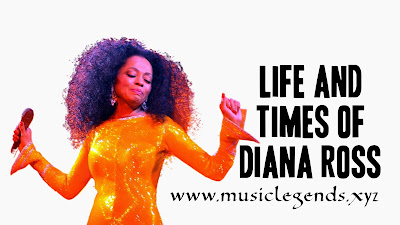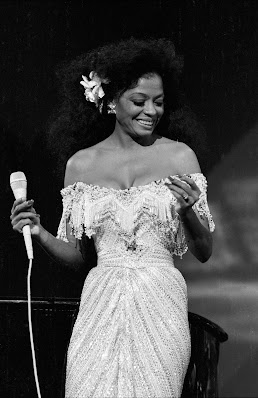Close your eyes and imagine the sound of the 1960s. The hopeful yearning of young love, the sophisticated swirl of sequined gowns, the crisp snap of a Motown backbeat, and soaring above it all, a voice of astonishing clarity and emotional depth – a voice that could be vulnerable one moment and fiercely determined the next. This is the voice of Diana Ross, a girl from the Detroit projects who would become an Empress of popular music. Her story is a quintessential American dream, woven with threads of ambition, glamour, heartbreak, and unparalleled success. From the prim harmonies of The Supremes to the glittering heights of a solo superstar and Hollywood actress, Diana Ross didn't just sing the soundtrack of our lives; she embodied the very idea of transformation and grace under pressure. This is the life and times of the one and only Miss Ross.
I will be embedding a specially curated Spotify playlist of Diana Ross's greatest hits right here! Stay tuned to listen along as you read.
The Beginning: A "Diane" Becomes a Diana in Detroit
Diana Ernestine Ross was born on March 26, 1944, at Hutzel Women's Hospital in Detroit, Michigan. Her story begins with a simple clerical error that would define an icon. Her parents, Fred and Ernestine Ross, intended to name their daughter Diane. But the clerk registering the birth mistakenly wrote "Diana," and the name stuck, perhaps foreshadowing a destiny too grand for a simple, single syllable.
She grew up in the North End of Detroit on Belmont Road, a tight-knit community where dreams often collided with the hard realities of a working-class life. Her family history was rooted in the deep soil of American struggle; her paternal grandparents had been slaves in Gloucester County, Virginia. This legacy of resilience would silently fuel her own drive. In a fascinating twist of fate, her childhood neighbor and friend was none other than William "Smokey" Robinson, a boy who would also become a Motown legend. Even then, Detroit was simmering with a musical talent that would soon explode onto the world stage.
Young Diana was initially shy, but she found her confidence and her voice singing in the Baptist choir at church. The gospel tradition gave her not just vocal training but a deep, soulful connection to music that would underpin even her most polished pop performances. By her mid-teens, the quiet girl from Belmont Road was ready to make some noise.
The Primettes to The Supremes: Where Dreams Were Born
At just 15 years old, Diana, along with friends Florence Ballard, Mary Wilson, and Betty McGlown, formed a sister group to the all-male Primes (who would later become The Temptations). They called themselves The Primettes. They were four teenage girls with big hair, bigger dreams, and a relentless hustle. They would hang around the fledgling Motown record label's headquarters, known as "Hitsville U.S.A.," begging for an audition.
Motown founder Berry Gordy initially thought they were too young and sent them away. Undeterred, they spent their time performing at sock hops, talent shows, and anywhere that would have them, building a local reputation. Their persistence paid off. In 1961, after a lineup change that saw Barbara Martin replace McGlown and then depart shortly after, the trio of Ross, Ballard, and Wilson signed to Motown as The Supremes.
The early years were a struggle. Between 1961 and 1963, they released eight singles that failed to make a significant chart impact. They were dubbed the "no-hit Supremes" within the label. But Berry Gordy saw something special, particularly in Diana's distinctive, commercial voice. He paired them with the songwriting and production powerhouse Holland-Dozier-Holland, and in the summer of 1964, lightning struck.
"Stop! In the Name of Love": Conquering America and the World
The song "Where Did Our Love Go" catapulted The Supremes to number one on the Billboard Hot 100 in August 1964. It was the first of an astonishing five consecutive number-one singles, a feat unmatched by any American group to this day. "Baby Love," "Come See About Me," "Stop! In the Name of Love," and "Back in My Arms Again" followed in rapid succession, making The Supremes a global phenomenon.
They were more than a singing group; they were an embodiment of the "Motown Sound" and the "Motown Look." Berry Gordy, with an eye for crossover appeal, polished their act to a high sheen. They performed in matching elegant gowns and wigs, with Diana gradually moving to the center as the lead singer. Their performances on programs like The Ed Sullivan Show brought them into living rooms across America, breaking racial barriers and presenting an image of Black sophistication and beauty that was revolutionary for its time.
However, this meteoric rise was not without its tensions. The group's name was changed to Diana Ross & the Supremes in 1967, highlighting Berry Gordy's focus on Diana as the star. This, combined with other internal issues, led to the departure of Florence Ballard and the arrival of Cindy Birdsong. The hits continued with "Reflections," "Love Child," and "Someday We'll Be Together," but the writing was on the wall. Berry Gordy was preparing his protégé for the ultimate solo leap.
TOP 66 DIANA ROSS SONGS PLAYLIST [VIDEO]
The Solo Ascent: "Ain't No Mountain High Enough"
Diana Ross's final performance with The Supremes was in January 1970 at the Frontier Hotel in Las Vegas. It was an emotional, lavish farewell. Just months later, she released her self-titled debut solo album. The centerpiece was a sprawling, spoken-word-to-gospel-crescendo reimagining of the Ashford & Simpson classic, "Ain't No Mountain High Enough."
The song was a declaration. It stormed the charts and became her first solo number-one hit in August 1970. The message was clear: Diana Ross was here to stay, and no obstacle would stand in her way. Her solo career was a masterclass in versatility. She could deliver soulful ballads like "Touch Me in the Morning," get funky on "The Boss," and command the disco era with anthems like "Love Hangover."
Her 1973 duet album with Marvin Gaye, Diana & Marvin, yielded the timeless classics "You're a Special Part of Me" and "My Mistake (Was to Love You)," showcasing a sultry, chemistry-filled side of her artistry. She was no longer just the girl from The Supremes; she was a mature, multifaceted artist in full command of her power.
"Lady Sings the Blues": The Silver Screen Siren
Not content with ruling the music world, Berry Gordy had an even bigger vision: to make Diana Ross a movie star. In a bold move, he cast her in the lead role of the 1972 Billie Holiday biopic, Lady Sings the Blues. Critics were skeptical. How could the polished pop princess convincingly portray the tortured, drug-addicted jazz legend?
Diana Ross silenced them all. She delivered a raw, powerful, and deeply committed performance that was hailed as a triumph. She spent months studying Holiday's mannerisms and voice, immersing herself in the role. The film was a massive commercial success, and Ross earned an Academy Award nomination for Best Actress, a Golden Globe nomination, and won a special Tony Award for her work. She had proven her mettle as a serious actress.
She followed this with Mahogany (1975), a glamorous fashion-world drama for which she also sang the theme song, "Do You Know Where You're Going To," and The Wiz (1978), an all-Black adaptation of The Wizard of Oz where she starred as Dorothy opposite Michael Jackson's Scarecrow. While The Wiz was not a commercial success, it cemented her status as a major box-office draw and showcased her willingness to take creative risks.
Love, Life, and Legacy: The Woman Behind the Glamour
Diana Ross's personal life has been as captivating as her career. Her most significant and complex relationship was with Motown founder Berry Gordy. Beginning around 1965, their romance was a powerful, behind-the-scenes force that shaped her career. Though she often expressed frustration with his controlling nature, their personal and professional partnership was the engine of her early success. They never married, but their bond produced a daughter, Rhonda Suzanne Silberstein.
She was married twice. Her first marriage was to music executive Robert Ellis Silberstein (1971-1977). Together they had two daughters, Tracee and Chudney. Her second marriage was to Norwegian shipping magnate Arne Næss Jr. (1985-2000). That union produced two sons, Ross and Evan. Through her children, her legacy continues, most notably with her daughter, Tracee Ellis Ross, who has become a celebrated actress in her own right.
Diana Ross's influence is immeasurable. She is a direct inspiration for generations of performers, from Michael Jackson and Madonna to Beyoncé, Christina Aguilera, and Jennifer Lopez. She showed that a Black woman could be the biggest pop star in the world, a glamorous movie star, and a savvy businesswoman, all while maintaining an aura of elegance and strength.
The Incomparable Discography: A Journey Through Sound
Diana Ross's career is documented in a stunning array of albums that showcase her evolution. Here is a comprehensive list of her major studio and soundtrack albums:
Studio Albums
- Diana Ross (1970)
- Everything Is Everything (1970)
- Surrender (1971)
- Touch Me in the Morning (1973)
- Diana & Marvin (with Marvin Gaye) (1973)
- Last Time I Saw Him (1973)
- Diana Ross (1976)
- Baby, It's Me (1977)
- Ross (1978)
- The Boss (1979)
- Diana (1980) - The landmark Nile Rodgers/Bernard Edwards-produced disco album.
- Why Do Fools Fall in Love (1981)
- Silk Electric (1982)
- Ross (1983)
- Swept Away (1984)
- Eaten Alive (1985)
- Red Hot Rhythm & Blues (1987)
- Workin' Overtime (1989)
- The Force Behind the Power (1991)
- A Very Special Season (1994)
- Take Me Higher (1995)
- Every Day Is a New Day (1999)
- Blue (2006) - A jazz album recorded in the 1970s but released decades later.
- I Love You (2006)
Soundtrack Albums
- Diana! (1971)
- Lady Sings the Blues (1972)
- Mahogany (1975)
- The Wiz (1978)
- Endless Love: Original Motion Picture Soundtrack (1981)
The Eternal Supreme: A Living Legend
Diana Ross's story is one of relentless ambition and timeless style. She redefined what was possible for a Black woman in entertainment, paving the way for countless others. From the church choir in Detroit to the main stage at Central Park, from the recording studios of Motown to the silver screen in Hollywood, her journey is a masterclass in artistry, resilience, and reinvention.
Even today, she continues to perform, her voice a timeless instrument of joy and strength. She is not just a singer or an actress; she is an experience. She is the sequins, the hair, the smile, and the unwavering belief that there truly is "Ain't No Mountain High Enough" to keep you from your dreams.
Let's Get Interactive: The Diana Ross Listening Challenge!
As you listen to the YouTube playlist above, take this challenge:
- Track the Evolution: Listen to a Supremes song like "Baby Love," then jump to "The Boss" (1979), and then to "I'm Coming Out" (1980). Can you hear how her sound evolved from 60s girl-group pop to sophisticated soul and then to revolutionary disco?
- The Voice of Emotion: Compare the vulnerable yearning in "Touch Me in the Morning" with the fierce independence of "The Boss." How does she use her voice to convey completely different emotions?
- Spot the Influence: As you listen, can you hear echoes of Diana Ross in the performances of artists like Beyoncé, Madonna, or Mariah Carey?
We'd love to hear from you! What is your favorite Diana Ross era? Is it The Supremes, her solo 70s soul, or her disco diva period? Do you have a favorite memory of one of her songs or movies? Share your thoughts in the comments below and let's celebrate the one and only Miss Diana Ross!






No comments: